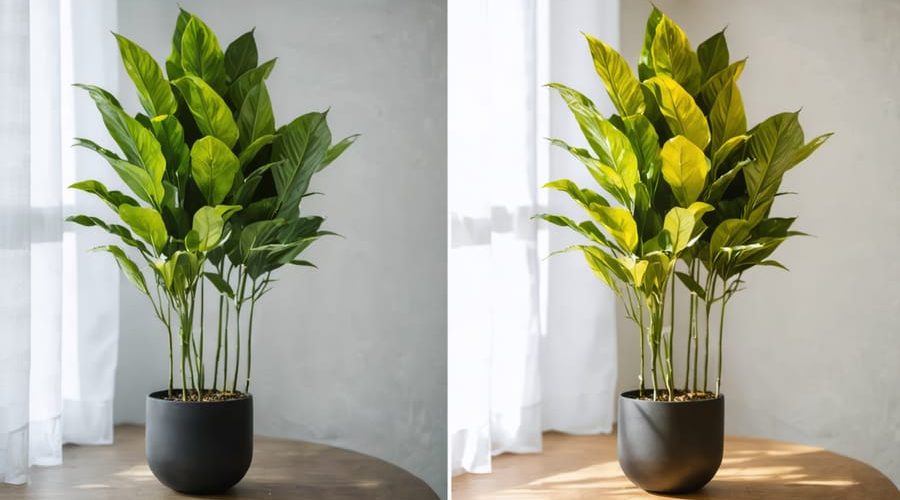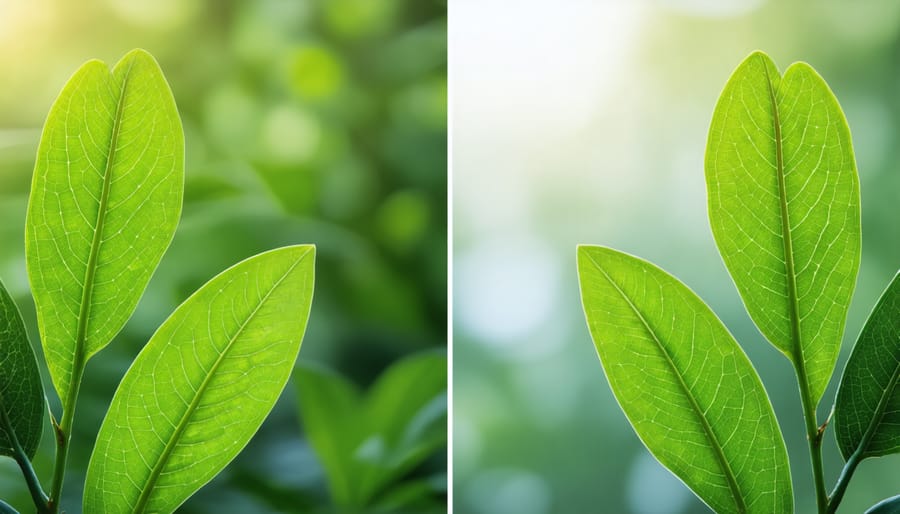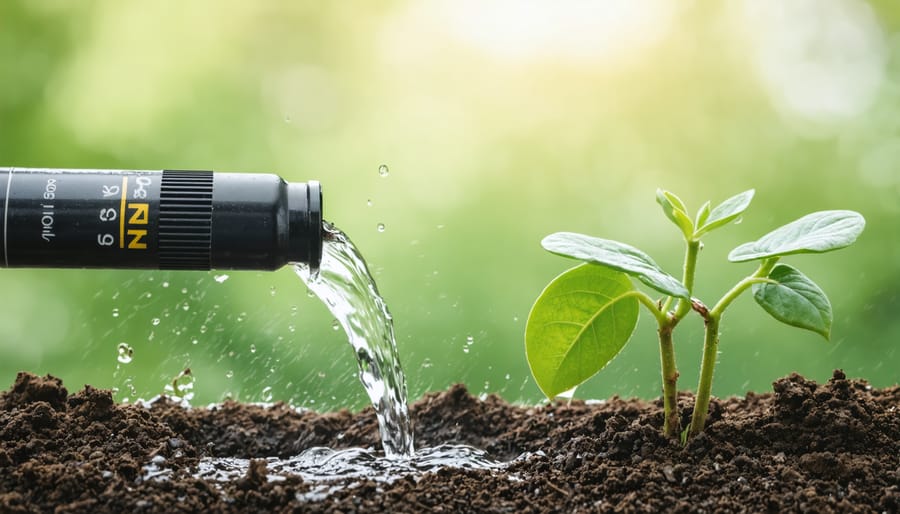
Summer Care: Keep Your ZZ Plant Thriving Without Drowning It
Water your ZZ plant every 2-3 weeks during summer months, allowing the soil to dry completely between waterings. These drought-tolerant houseplants thrive on neglect and are far more susceptible to overwatering than underwatering in warm weather. Check moisture levels by inserting your finger 2 inches into the soil – only water when it feels completely dry at this depth.
Summer care for ZZ plants requires careful attention to environmental signals. Yellowing leaves indicate overwatering, while slight wrinkling of stems suggests it’s time to water. Adjust your watering schedule based on factors like humidity, air conditioning, and direct sunlight exposure, which all impact how quickly soil dries out.
Despite the increased temperatures, ZZ plants maintain their water-storing capabilities through thick rhizomes and succulent stems, making them remarkably resilient during hot weather. Reduce watering frequency immediately if you notice any signs of root rot, such as mushy stems or black spots on leaves. This adaptive approach ensures your ZZ plant remains healthy throughout the summer season.
Understanding Your ZZ Plant’s Summer Water Needs
Signs Your ZZ Plant is Thirsty
Your ZZ plant will clearly communicate when it needs water through several visual cues. The most obvious sign is when the soil feels completely dry to the touch – stick your finger about 2 inches deep into the soil to check. As these plants adapt to different seasonal watering needs, pay attention to leaf appearance. Wrinkled or curling leaves often indicate thirst, while normally firm stems may appear slightly softer. You might notice the plant’s stalks beginning to droop or lean more than usual. The leaves may also lose their characteristic shine and appear dull. In severe cases, leaves might develop brown edges or tips. Don’t wait until you see multiple signs of distress – it’s best to water when you notice the first hints of thirst. Remember, it’s easier to save an underwatered ZZ plant than an overwatered one, so when in doubt, wait another day before watering.
Warning Signs of Overwatering
Even the drought-tolerant ZZ plant can suffer from too much love in the form of overwatering. Keep an eye out for yellowing leaves, which are often the first sign that you’re being too generous with water. If you notice soft, mushy stems or leaves that feel squishy to the touch, your plant is definitely getting more water than it needs. Black spots on the leaves and a foul smell coming from the soil are serious red flags that indicate potential root rot.
Check the soil moisture by inserting your finger about 2 inches deep – if it feels consistently wet or soggy, you’re watering too frequently. A healthy ZZ plant should have firm, glossy leaves and stems that stand upright. If leaves are dropping off easily or the plant seems unstable in its pot, inspect the roots immediately. Healthy roots should be firm and white or light tan, while rotting roots appear brown, black, and mushy.

Perfect Summer Watering Schedule
Indoor vs. Outdoor ZZ Plants
The location of your ZZ plant significantly impacts its watering needs during summer. Indoor ZZ plants generally require less frequent watering compared to those placed outdoors, as they’re protected from direct sunlight and intense heat. In air-conditioned spaces, you might only need to water every 2-3 weeks, as the controlled environment helps maintain consistent soil moisture.
Outdoor ZZ plants, however, face more environmental challenges. Higher temperatures, wind exposure, and direct sunlight can cause the soil to dry out faster, potentially requiring weekly watering during peak summer months. If your outdoor ZZ plant is in a partially shaded area, you can water less frequently than those in full sun locations.
For both indoor and outdoor plants, always check the soil moisture before watering. Insert your finger about 2 inches into the soil – if it feels dry at this depth, it’s time to water. Remember that outdoor plants might need closer monitoring, especially during heat waves or particularly dry spells. Always adjust your watering schedule based on your specific environment and your plant’s response.
Adjusting for Humidity and Temperature
During summer, your ZZ plant’s watering needs can vary significantly based on your local climate. Understanding smart water management practices is crucial for maintaining healthy growth. In high-humidity environments, ZZ plants require less frequent watering as they can absorb moisture from the air. Check the soil moisture by inserting your finger about 2 inches deep – if it feels damp, wait a few more days before watering.
For homes with air conditioning, monitor your plant more closely as indoor air tends to be drier. Temperature also plays a vital role in adapting to climate conditions. When temperatures consistently stay above 75°F (24°C), your ZZ plant might need slightly more frequent watering, perhaps every 2-3 weeks instead of the usual monthly schedule.
Remember to adjust gradually – it’s better to underwater than overwater these drought-tolerant plants. Keep a simple watering log to track how your plant responds to different conditions, helping you fine-tune your care routine throughout the summer months.

Best Watering Practices
When watering your ZZ plant in summer, it’s essential to use the right technique to ensure healthy growth. Always check the soil moisture by inserting your finger about 2 inches deep into the soil – if it feels dry at this depth, it’s time to water.
Water thoroughly until you see it flowing from the drainage holes, but avoid letting the plant sit in standing water. Empty the saucer after about 15 minutes to prevent root rot. It’s better to water deeply but less frequently than to give small amounts more often, as this encourages stronger root development.
Choose room temperature water rather than cold, as this prevents shock to the root system. Water at the base of the plant rather than from above to keep the leaves dry and reduce the risk of fungal issues. Early morning is the ideal time for watering, giving the plant all day to process the moisture.
If you’re unsure whether to water, remember that ZZ plants are more tolerant of underwatering than overwatering. Look for visual cues like slightly wrinkled leaves or stems that are losing their firmness – these are signs that your plant needs a drink. During particularly hot summer days, you might need to increase watering frequency, but always let the soil dry between waterings.
For optimal results, use well-draining potting soil and ensure your pot has adequate drainage holes. This combination helps prevent water-logging while maintaining just the right moisture level for your ZZ plant to thrive.
Proper summer watering is crucial for keeping your ZZ plant healthy and thriving. Remember to water your ZZ plant every 2-3 weeks during summer, adjusting this schedule based on your specific indoor conditions. Always check the soil moisture before watering – if the top 2-3 inches feel dry, it’s time to water. Don’t forget that ZZ plants are incredibly resilient and prefer being slightly underwatered rather than overwatered. Monitor your plant’s leaves for signs of stress, and adjust your watering routine accordingly. With these guidelines in mind, you’ll be able to maintain the perfect balance of moisture for your ZZ plant throughout the summer months, ensuring it remains a beautiful, low-maintenance addition to your indoor garden.
